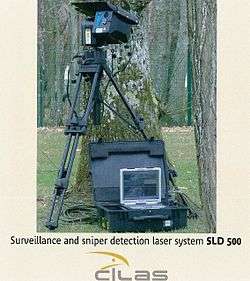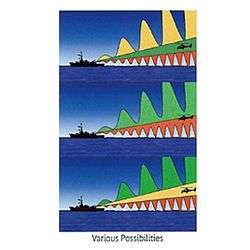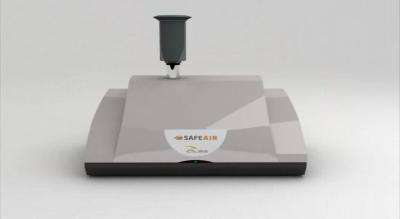CILAS
|
| |
| S.A. (corporation) | |
| Founded | 1966 |
| Headquarters | Orléans, France |
Key people | Philippe Lugherini |
| Revenue | 26,7 million € (2009) |
Number of employees | 170 (2009) |
| Website | www.cilas.com |
CILAS is a French company, a subsidiary of EADS Astrium, specialized in laser and optics technology, founded in 1966. This high-technology engineering company was the inventor of the particle size analyzer. Today, it develops, manufactures and produces systems combining laser and precision optics in the field of high technology, accounting. Products for the military represent 50% of turnover against 50% civilian.
History
This company was founded in 1966 by two companies : CGE (Compagnie Generale d'Électricité becoming Alcatel-Alsthom) and Saint-Gobain. The aim was to exploit industrially and commercially the work of laboratories working on laser sources and laser equipment.
In 1983, it became CILAS-Alcatel. In 1985, it was absorbed by two companies of optics : SORO Electro-Optics and BBT (Barbier Bernard and Turenne). Alcatel withdraws its laser activities in 1989, resulting in a change of ownership. In early 1990, the capital is divided between three companies, CEA Industries (now Areva), SAT and Unilaser Holding (Aerospace Group). CILAS-Alcatel becomes CILAS.
Meanwhile, from late 1989, the Unilaser group also acquired the Optronics Division of Alcatel Marcoussis laboratories and named it Laserdot. Unilaser now gather Quantel, LISA, CILAS and Laserdot.
From this moment, Laserdot and CILAS collaborate on joint projects. Laserdot is more oriented toward research and development whereas CILAS toward industrialization and production.
In 1994, SAT withdraws CILAS' capital and shares of the two remaining shareholders passed to 57% for Unilaser and 43% for CEA Industry. On September 1, 1995, CILAS and Laserdot are merged into a single entity which reteins the name CILAS.
Defence and security
Cilas develops and manufactures different products in the field of defence and security. It offers laser designators, counter-snipers optical sight systems detectors, rangefinders, airborne laser sources and shipborne helicopters landing aids.
Optics detector : The SLD 500 laser surveillance system and sniper detector is a reliable tool for surveillance of sensitive areas and critical infrastructures protection. The system can detect and locate any kind of optical sight systems: optical scopes used by snipers or optronic sight systems. Not only is it capable of accurately localizing a threat, the system can also perform clear target identification using a high definition daylight camera or an infrared camera for night vision.
| Optics detector |
 |
Laser designator : The DHY 307 ground laser target designator belongs to the Modular Illuminating Range Finders (TIM) family developed by CILAS. Intended for use by small ground units, it provides precision guidance for any missile, bomb or shell fitted with final laser guidance targeting an individual tactical objective.
| Laser target designator |
Helicopter visual landing aids system : Safecopter is a complete lighting system formed by a Glide Slope Indicator with a lighting deck system. The SAFECOPTER provides day and night, in all weather, perfect safety for pilots during landing of helicopters.
| SAFECOPTER |
 |
Particle size analysis
Over 30 years ago, CILAS developed the world's first diffraction laser particle size analyzer for industrial applications. Since then, CILAS has been the market leader in product innovation; constantly striving to make their particle size analyzer easier to use, more reliable and flexible. CILAS' state of the art laser particle size analyzer include features such as their patented short optical branch, intuitive software interface and a 2 in 1 design which effortlessly integrates wet and dry modes in the same system. CILAS particle size analyzer works on determination and on control of the particle size in powder matter, in suspension or in emulsion which meet the needs of many and various fields like cement, ceramics, manufacturing industries, pharmaceuticals, cosmetics, biology, food or environmental industries.
Optical coatings
CILAS uses a wide range of technologies which allow to target various applications in scientific, industrial, military and space fields : classical evaporation, assisted evaporation, ion beam assisted deposition, magnetron sputtering. The production means are suitable for large quantities of optical components, and automated to ensure the best reproducibility. It produces : • Optical components : lenses, mirrors, optical fibers, optromechanical systems • UV range : anti-reflection coatings, enhanced metallic coatings • Visible and near-IR range : anti-reflection coatings, metallic and dielectric coatings, absorbing coatings, partially reflective coatings, beam-splitters, filters • IR range : anti-reflection coatings, metallic mirrors, filters
Adaptive optics
Image has become an important tool for communication and scientific knowledge. When passing through distorting and turbulent media, Light waves and therefore images are distorted and blurred. Since several years, the adaptive optic has become an essential component for Wave Front Correction, and has found numerous applications in astronomy, military observation, correction of scientific and industrial laser beams, and in medical imaging, especially in ophthalmology.
An Adaptive Optics system is a device which corrects, in real time, perturbed optical wavefronts. It is composed of an analyzer which measures the wave deformation; a deformable mirror which corrects the wavefront; and a computer which drives the mirror with informations coming from the analyzer.
Optical ceramics
CILAS develops transparent ceramics that are usable as optical components. These top-quality materials, which have an excellent level of resistance and transparency, are fabricated using new synthesis techniques.
CILAS optical ceramics are the fruit of research that has been conducted by the Limoges Ceramic Processes and Surface Treatment Sciences Laboratory (SPCTS), a Joint Research Unit federating the French National Centre for Scientific Research (CNRS) and the local university, for some ten years. The SPCTS has developed a process to fabricate transparent ceramics, known as “YAG” (due to the name of the components: Yttrium and Aluminium Garnet). The feasibility of this operation was proven in cooperation with the Solids Modelling, Properties and Structures laboratory at the prestigious Ecole Centrale in Paris.
This transparent ceramic production activity is also the fruit of a partnership between CILAS, Rhodia Electronics & Catalysis and the European Centre of Ceramics within the framework of the Ceramoptic project. This project is backed by the French Minister for Industry, the Limousin region and the City of Limoges.
Nanotechnology
The term nanotechnologies refers to all theories and techniques used to produce and handle minuscule objects equal in size to one billionth of a metre (i.e. a nanometre). This technology requires very high precision tools to visualise, detect and analyse activities on such a small scale.
The nanotechnologies sector is flourishing, with nanotechnology company turnover growing 100 times quicker than information technology majors.
In this domain, CILAS coordinates the European project Saphir for the safe, integrated and controlled production of nanostructured products.
Recently, CILAS has developed a new product : the Nanoparticle aerosol monitor - SafeAir.
 |
References
- The M4 adaptive unit for the E-ELT, B Crepy, 2009
- Multifunction laser source for ground and airborne applications, B Crepy, 4th International Symposium on Optronics in Defence and security in Paris, 2010
- Mechanism of the liquid-phase sintering for Nd:YAG ceramics, R. Bouleisteix, A. Maître, J-F. Baumard, C. Sallé, Y. Rabinovitch, 2008 (elsevier)
- Five factors to consider when choosing a particle size analyzer, Nicolas Marchet, PBE/I, 2010
- Conference ceramics department - Optro 2010, Y. Rabinovitch, 2010
- Progress on the laser source for DIRCM presented for the 4th International Symposium on Optronics in Defence and security in Paris (2010), B, Crépy, 2009
- Stand-off biological detection by lif (laser induced fluorescence) lidar - Optro 2010, O. Meyer, 2010
- Temperature insensitive laser for very compact designation function on small platforms - Optro 2010, J. Montagne, 2010